American campuses have not looked like this in more than 50 years, and never for the reasons they do now. The foreign war that students protested in the 1960s and ’70s was one that, even amid draft deferments, threatened their own lives. What has stirred students to risk their safety, enrollment, and future careers on hundreds of campuses this spring is the deaths of others–the 34,000 Palestinians killed in the Gaza Strip since Israel launched its retaliation for the Oct. 7 Hamas attack that killed 1,200 and took 240 hostage.
The protesters’ point of reference is the 1980s campaign for divestment from apartheid South Africa. In their campaign, aimed at what they see as financial complicity in Israel’s actions, the activists—many swathed in kaffiyehs and living in tents, if they haven’t already been forced out by their universities—embody a generational divide previously visible only in polling: young Americans who have known Israel only during its occupation of the West Bank and blockade of Gaza are more disposed to the Palestinian cause than are those old enough to remember it first fighting, in the shadow of the Holocaust, to create a safe place for the world’s Jews.
This is the conflict that has thrust America’s colleges back into position as the crucible in which the nation works out its moral questions. Student journalists have been the ones to document the resulting conflagration—especially on campuses that barred the professional press from bearing witness. TIME reached out to student photojournalists from across the country to tell this story.
Read more: The story behind TIME’s campus protests cover
GEORGE WASHINGTON UNIVERSITY
From the journalists of the GW Hatchet
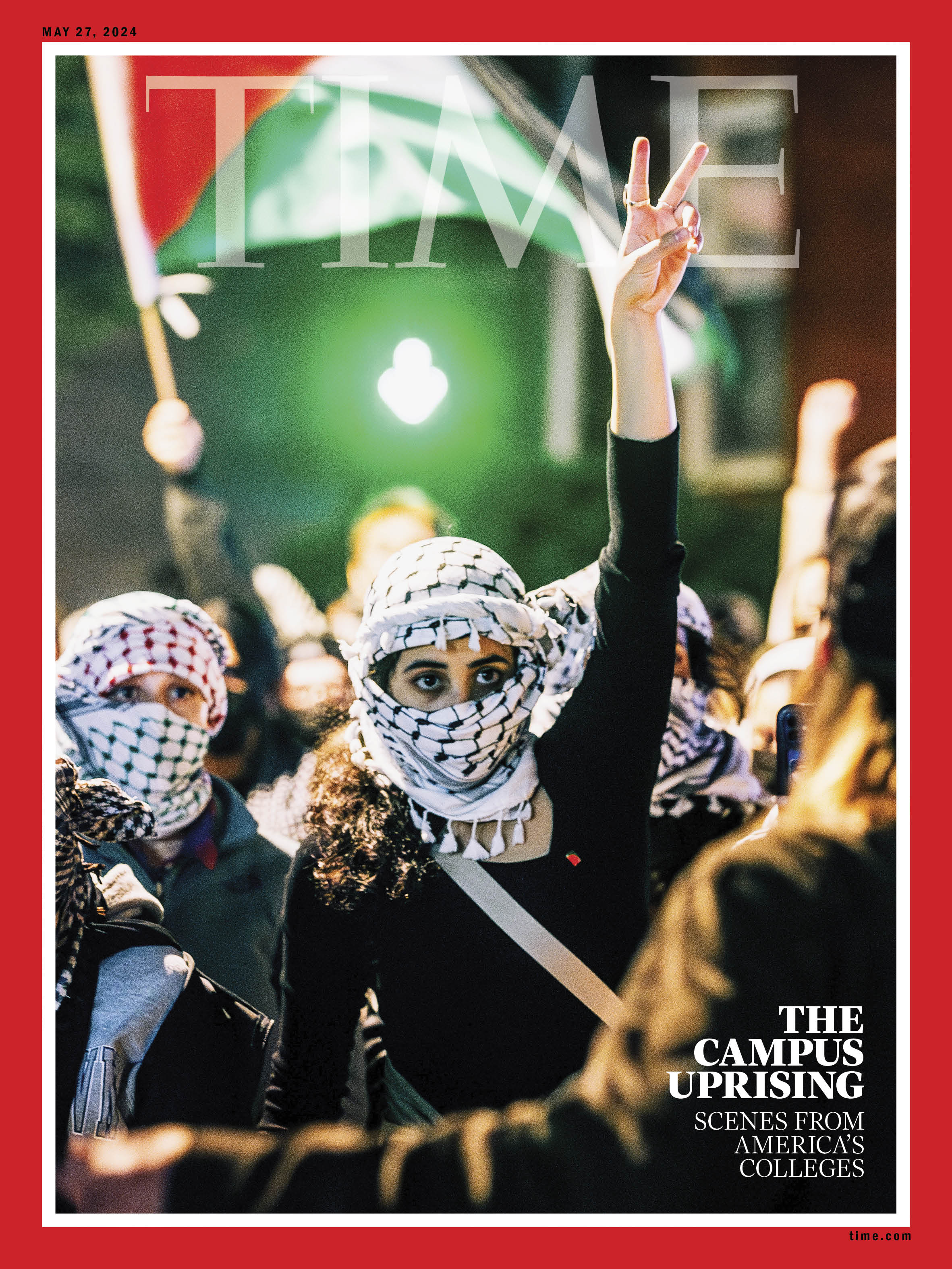
Purchase a copy of this issue here
On the second night of the pro-Palestinian encampment at George Washington University, drums played as an organizer fired up the crowd. Speaking near the tents, he asked how George Washington University could be nicknamed the Revolutionaries if they weren’t advocating strongly for peace in Gaza. James Devin Schaap, a 28-year-old graduate student at the university’s photojournalism program, was covering the speech for the GW Hatchet when a masked protester with a fierce gaze caught his eye. The protester, who appeared resolute throughout the night, raised a hand in a peace sign. “I thought, well, I gotta get that,” Schaap says. Her expression “definitely gives the impression that this person absolutely and wholeheartedly believes in the cause that she's fighting for in Gaza,” he adds.
Read more: Biden Condemns Campus Unrest Over Israel-Hamas War: ‘None of This Is a Peaceful Protest’
The green light shining in the distance reminded Schaap of the green light in The Great Gatsby, in addition to bringing out the color of the Palestinian flag. He adds that he is a literary-history nerd.
Schaap had a feeling after Columbia University’s president authorized police on April 18 to remove students participating in an encampment on that campus that a similar demonstration might emerge at George Washington University. When it did, on April 25, “in my mind it was like, OK, this will be like maybe a day or two ordeal,” he says. “And then it kept going.” It lasted for nearly two weeks as police resisted calls from the university to clear it. On May 8, however, law enforcement moved in with pepper spray, removing tents and arresting protesters.
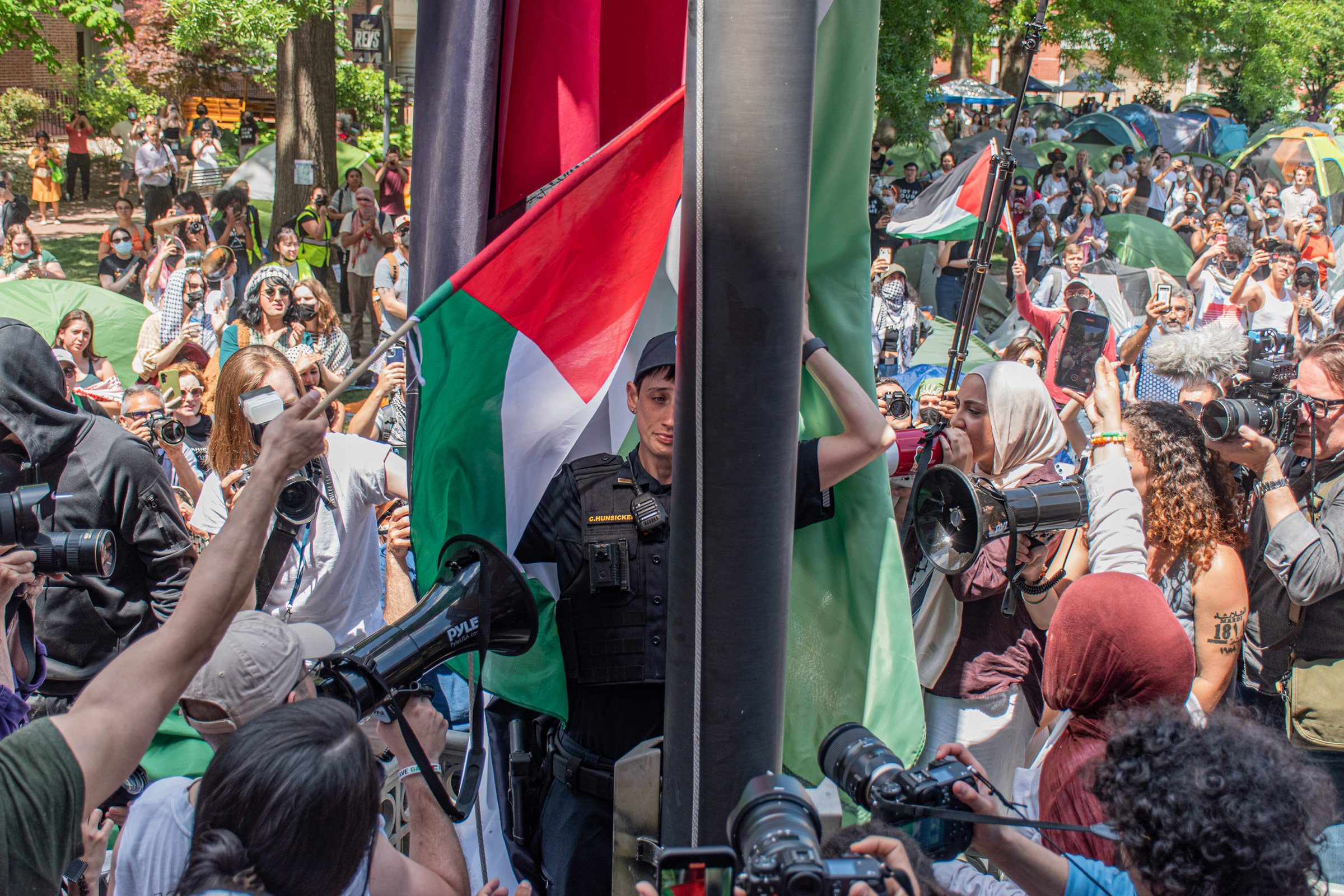


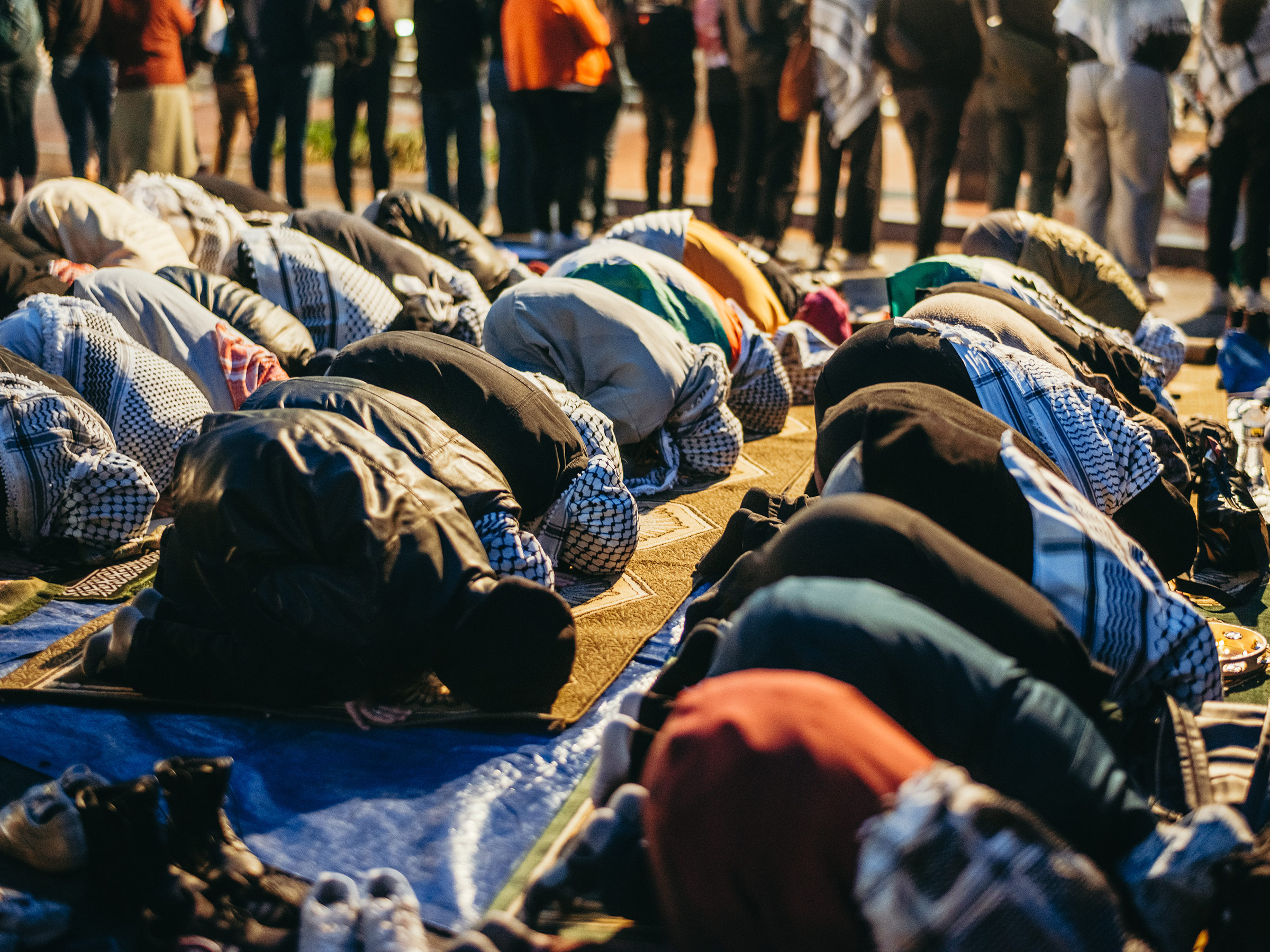
What struck Tom Rath most about this moment was “the silence of it all.” The GW Hatchet photojournalist had gotten used to the loud chants. But here, a group of students prayed as their peers created a perimeter around them. “It really, to me, spoke to this being larger than just like a one-day protest or something that people show up to and then immediately go home,” he says. “People are being vulnerable here…People were using themselves—even their physical bodies—in ways to protect their fellow protesters and students.”
For Rath, a 20-year-old sophomore, the moment reflected real community-building among protesters at D.C.-area universities, even if they didn’t share the same religion. “You could tell that even the people that weren’t engaged in the prayer were feeling the emotions of the moment,” he says. The encampment, which started at University Yard and spread to H Street, consisted of student protesters from George Washington University, Georgetown University, American University, and others in the area.
Read more: ‘Why Are Police in Riot Gear?’: Inside Columbia and City College’s Darkest Night
These less sensational moments are “lost on a lot of people who don't live here and they're just showing up when things are kind of tense and then they leave right away,” he says.
On April 29, protesters breached barriers around the yard. On May 1 a group of Republican lawmakers on the U.S. House Oversight Committee visited campus, urging D.C. to crack down on the protests. Rath notes that they said some “fairly inflammatory things'' about protesters that are not “reflective of what the whole vibe has been here.”
“The mayor must step up and do something to clear this,” said Rep. Lauren Boebert (R-Colo.) during the visit. “This is not the summer of love, and we are not bowing a knee to the terrorists who caused the riots and chaos in our cities anymore.”
Rath notes that being in D.C. means that students are in close proximity to Congress. “Sometimes you forget that until politicians show up on campus,” he says. “But also it does feel very politically driven—it feels like it was to get cameras on them and to get sound bites.”
On May 2, protesters replaced a university flag with a Palestinian one; law enforcement has since taken that down. Then early on May 8, just hours before D.C. Mayor Muriel Bowser and Metropolitan Police Department Chief Pamela Smith were scheduled to testify before Congress over the city’s initial refusal to send in law enforcement, police cleared the encampment. More than 30 protesters were arrested, and the hearing was canceled.
VANDERBILT UNIVERSITY
From the journalists of theVanderbilt Hustler

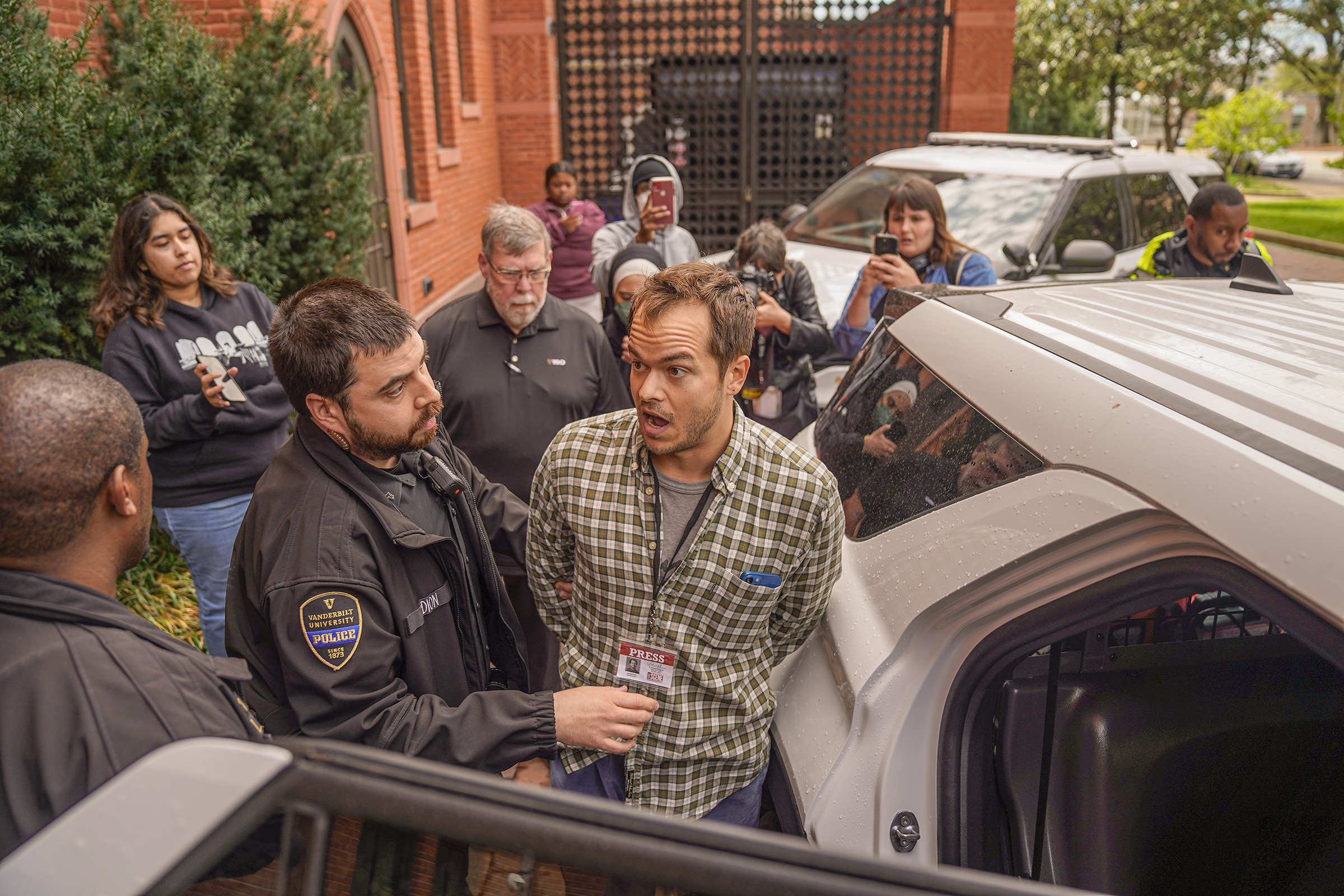
UNIVERSITY OF SOUTHERN CALIFORNIA
From the journalists of Daily Trojan

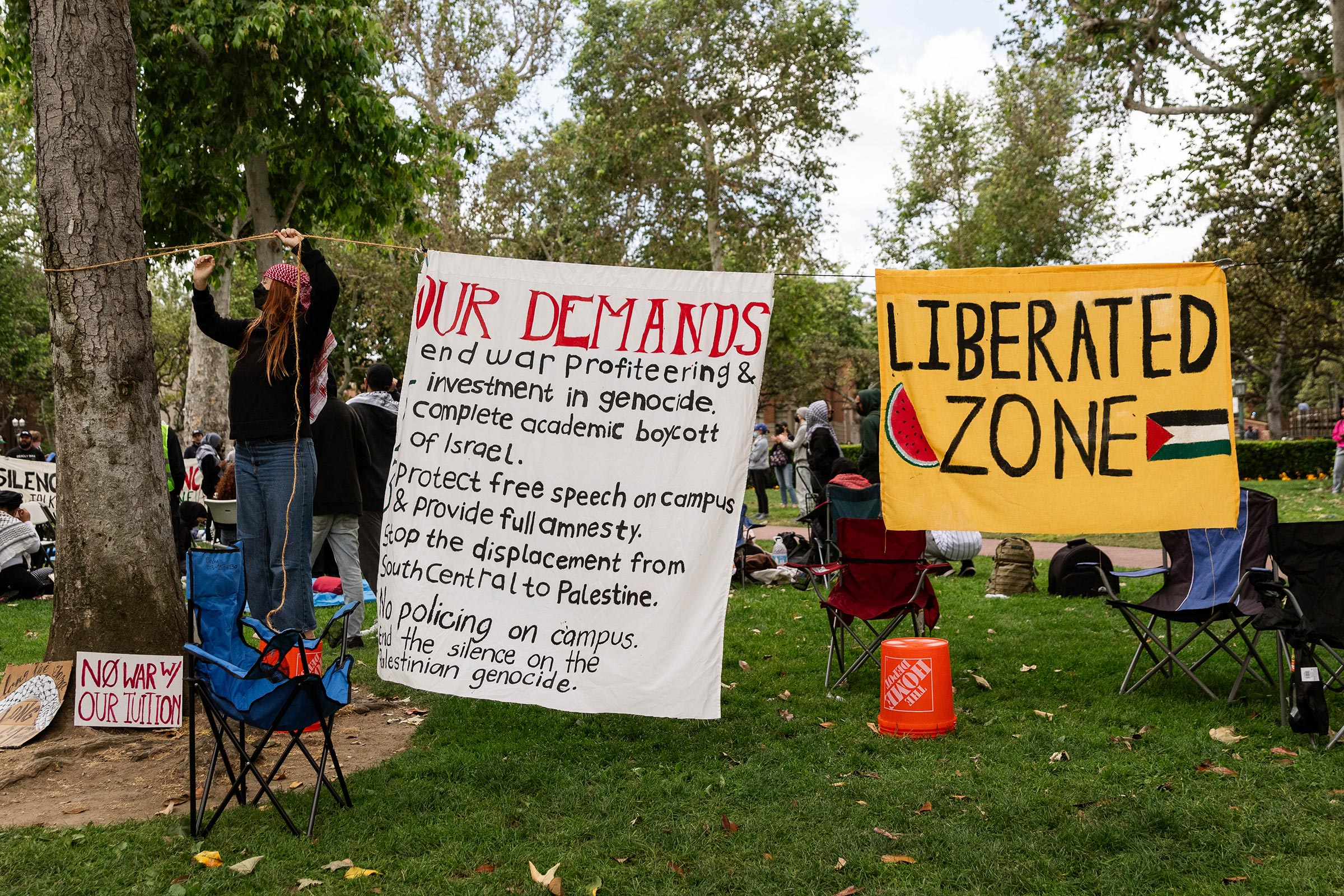

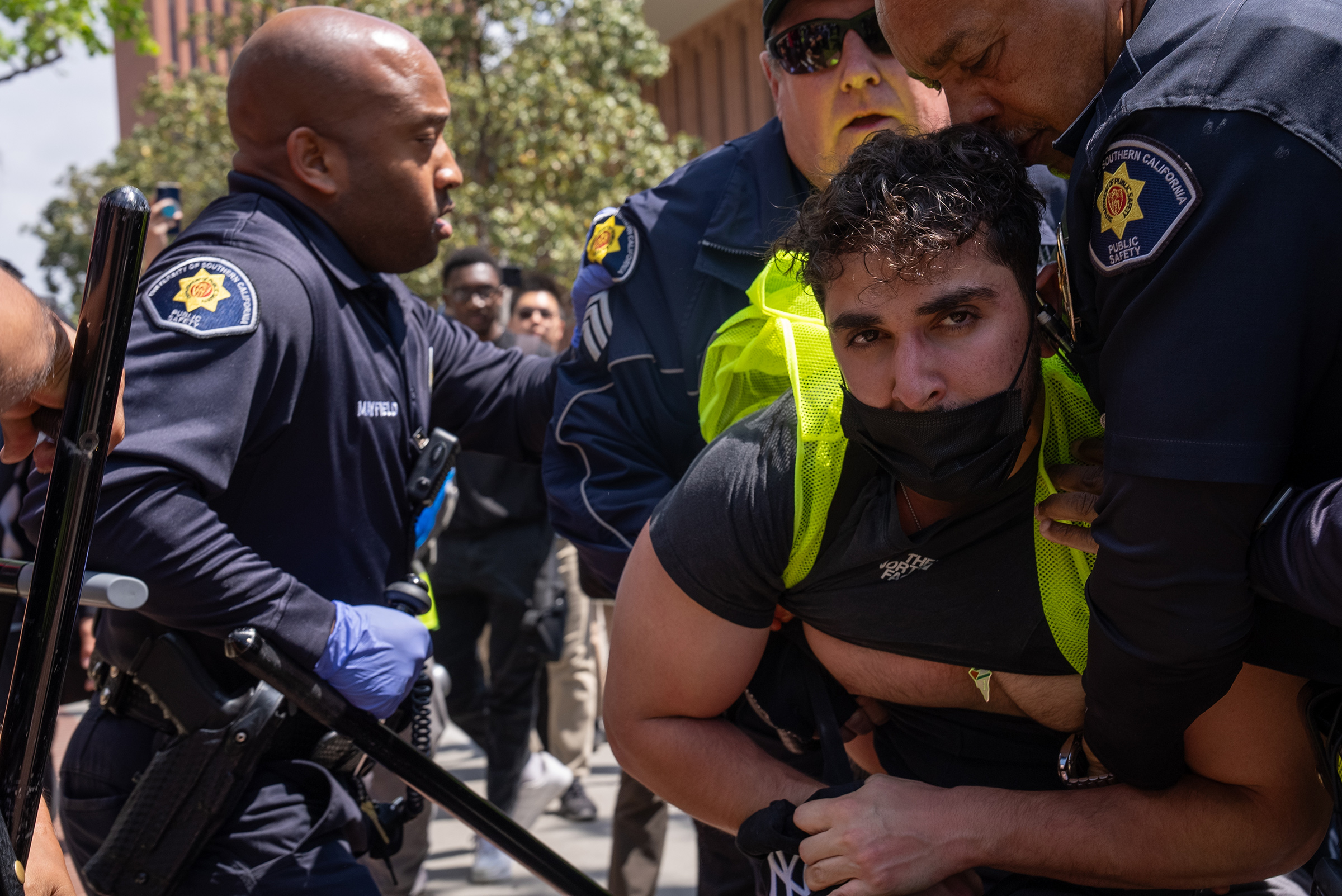
INDIANA UNIVERSITY
From the journalists of the Indiana Daily Student

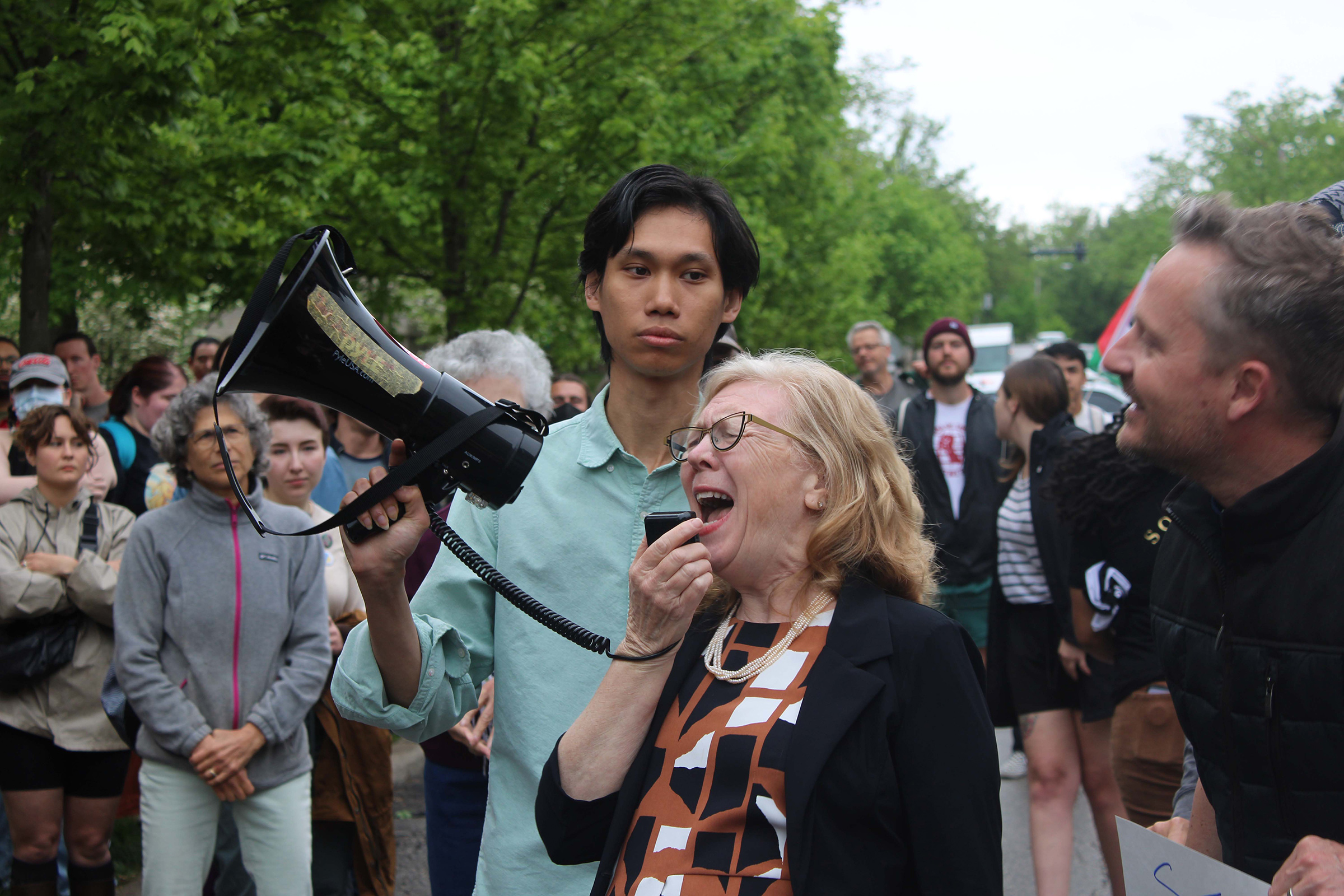
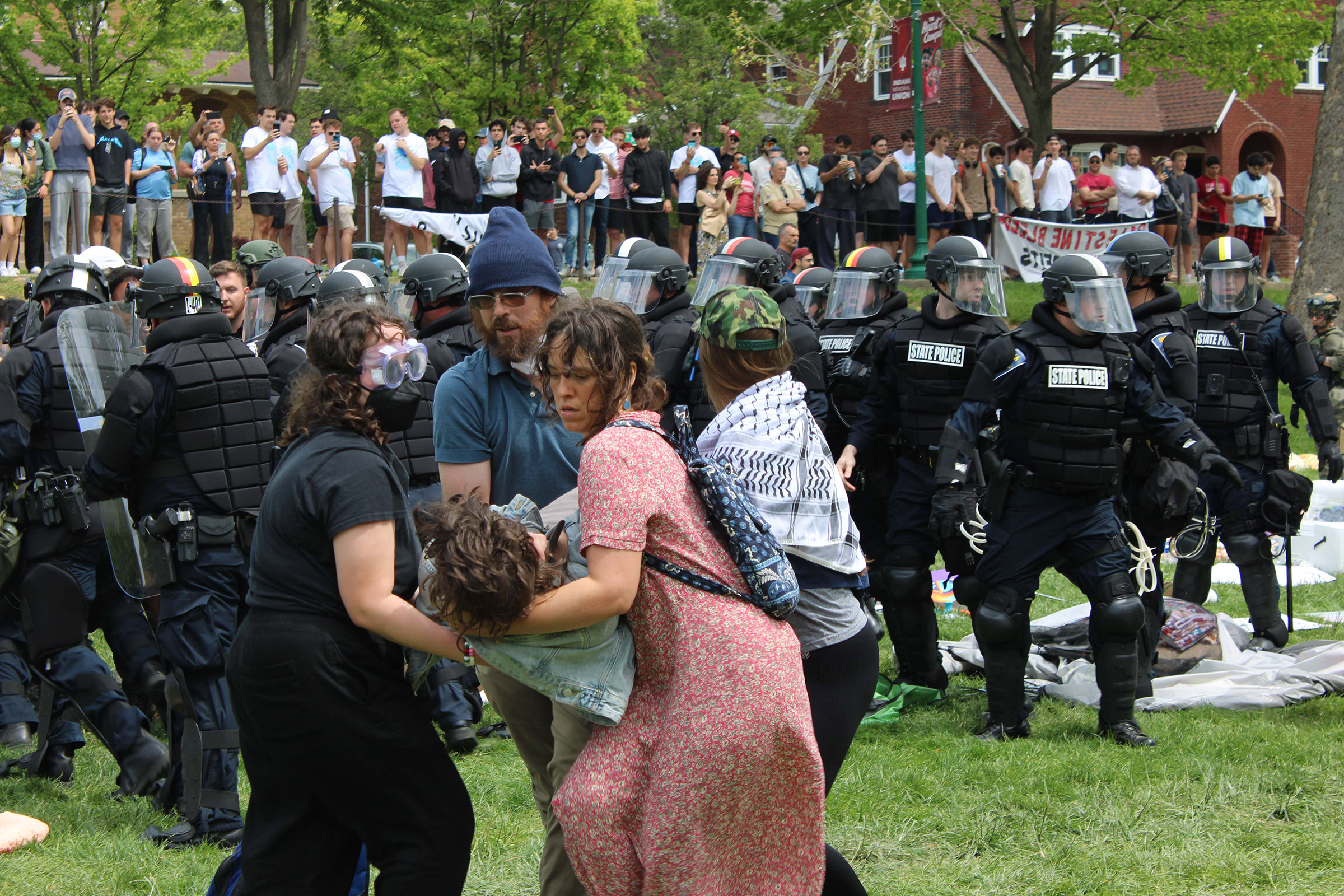
PRINCETON UNIVERSITY
From the journalists of the Daily Princetonian

Calvin Kenjiro Grover, a photojournalist for the Daily Princetonian, remembers how good the maqluba smelled. Someone had cooked and brought the traditional Palestinian rice dish to Princeton University’s “Gaza Solidarity Encampment” on April 28. Protesters had offered journalists a bite, but Grover politely declined. “For journalistic purposes, we couldn't accept their offer,” he says.
Instead, he took pictures. For Grover, a 19-year-old freshman, it was important to capture these moments of community. “It’s easy to get swept up in the narrative of the most exciting images,” Grover says. But often there are no big speeches or arrests. “In between is all this quiet space—like the middle of the night, early morning—when people are just hanging out,” he says.
Read more: Pro-Palestinian Campus Protests Highlight Divisions Among Democrats
At Princeton University, the encampment is still running, with students doubling down on calls for divestment from Israel. Thirteen pro-Palestinian protesters were arrested after occupying an academic building on April 30. On May 3, at least a dozen students started a hunger strike as a “response to the administration's refusal to engage” on divestment negotiations.
For Grover, it feels impossible to separate the recent Gaza protests from Princeton’s long history of sit-ins and demonstrations. That makes it even more important for him to “photograph the sea change as it’s occurring,” he says. “These images are what is going to be remembered as we look back in the future.”
Grover keeps coming back to something one of the protest organizers said in a speech: Community is the greatest weapon against overwhelming grief. “This sense of community that's formed is a very interesting manifestation of that that I think is worth acknowledging,” Grover says, “even among all this craziness with arrests and demonstrations that takes the spotlight.”
RUTGERS UNIVERSITY
From the journalists of the Daily Targum
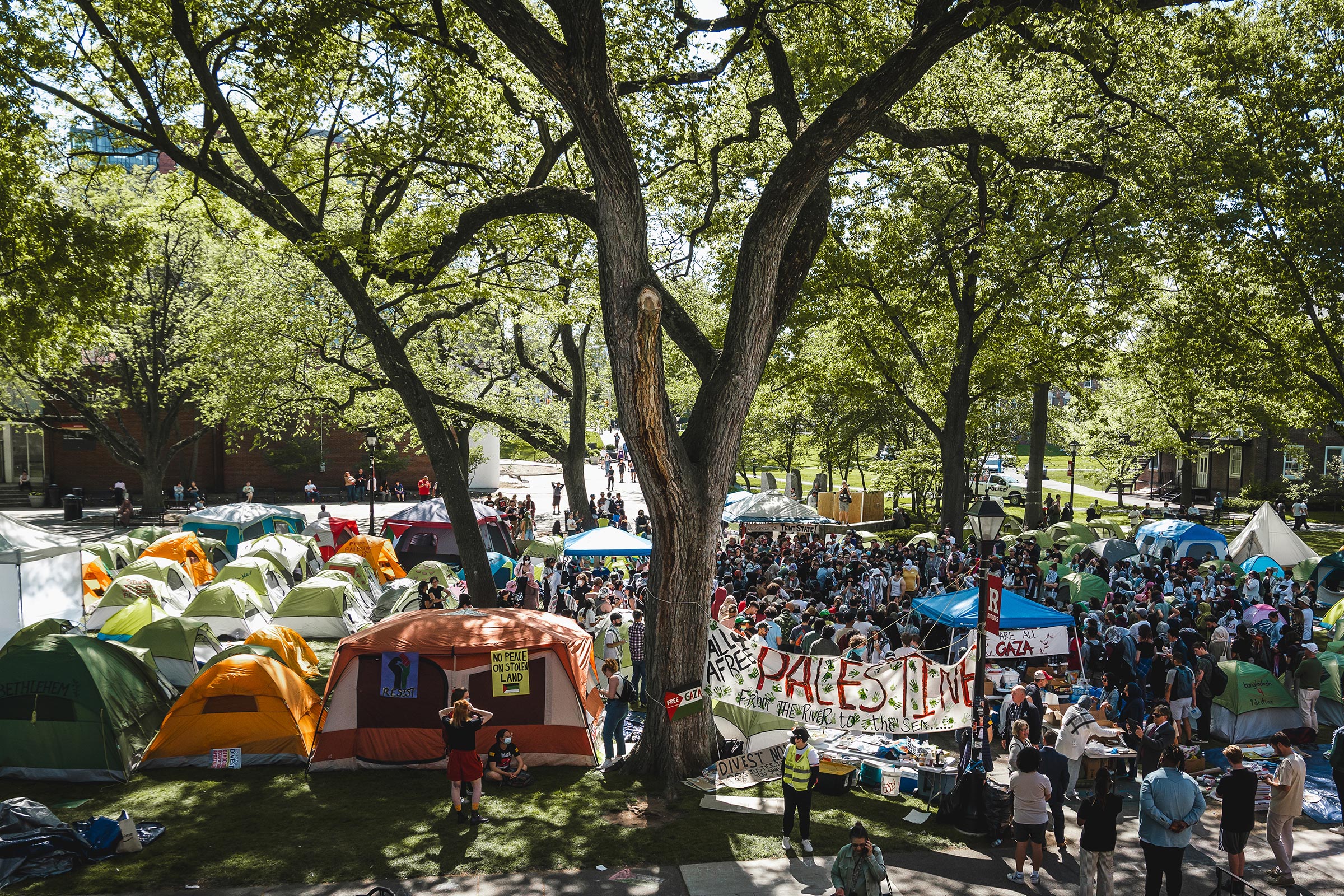
NORTHWESTERN UNIVERSITY
From the journalists of the Daily Northwestern
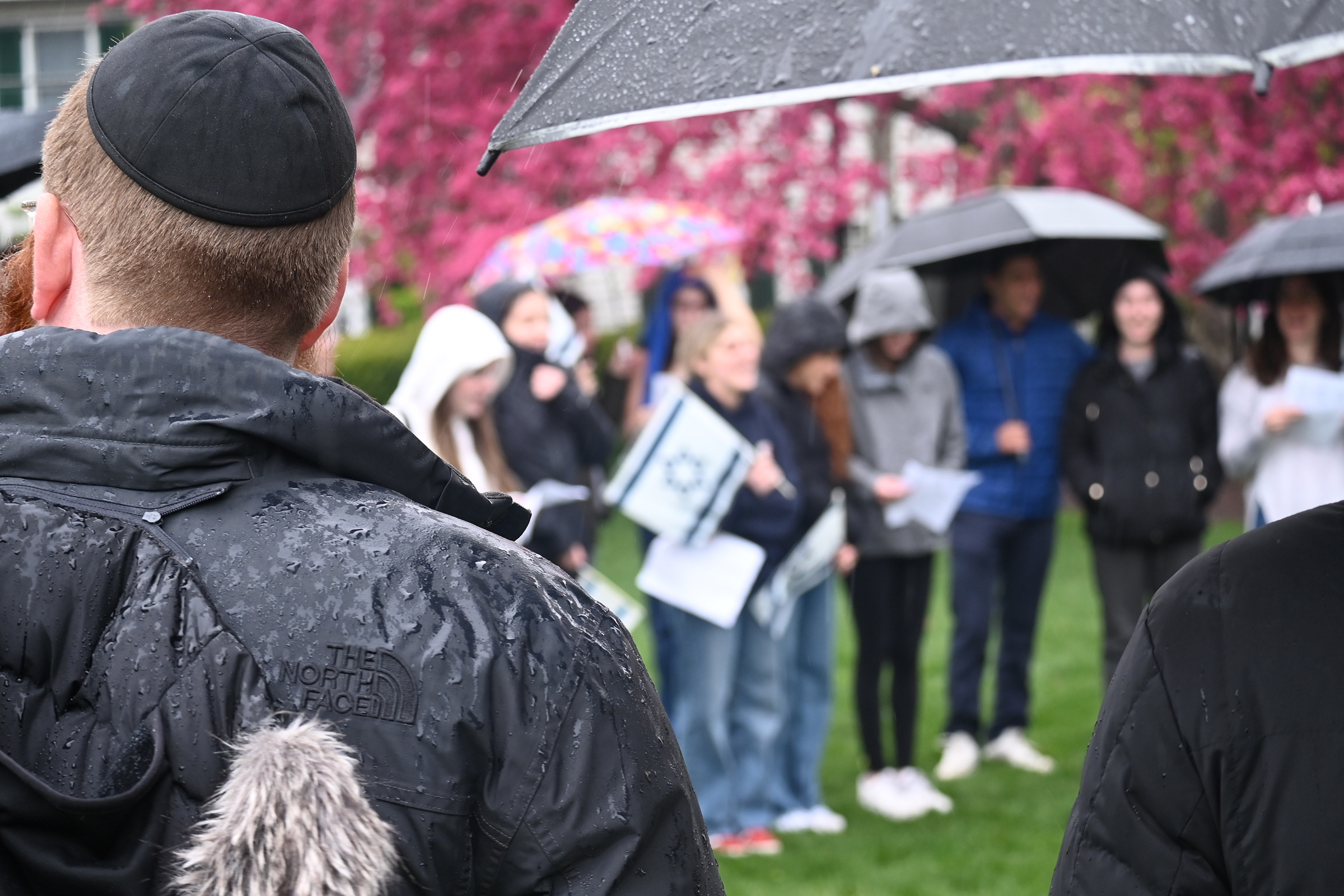
At Northwestern University, a few dozen Jewish students gathered on April 26—not far from the pro-Palestinian encampment—to sing Hebrew songs in the rain.
Michael Simon, executive director of Northwestern Hillel, told The Daily Northwestern’s print managing editor Nicole Markus that “there were some people who were feeling uncomfortable or distressed about the events that were happening on campus,” she says. “This was something he thought that they could do to bring Jewish students together and … celebrate Passover as a community.”
Read more: Pro-Palestinian Protests Spark on College Campuses Across the Globe
In November, Northwestern president Michael Schill announced a committee on preventing antisemitism and hate. While he did mention a commitment to fighting Islamophobia, critics still worried it was not a priority and said that criticizing Israel had been conflated with antisemitism. Schill is expected to testify before Congress about antisemitism on campus on May 23.
For Markus, a 21-year-old junior, student journalism provides essential nuanced local reporting. “Because we are students, we understand the complexities of what's happening on our campus a lot more than the national media could,” she says. She notes, for instance, that there’s a Northwestern chapter of Jewish Voice for Peace, which was part of the coalition calling for divestment. “A lot of those students were present at the encampment,” she says. “We also heard on the other side of things, from Jewish students who maybe didn't agree with the message of the encampment.”
Northwestern was one of the first universities to reach an agreement with protesters at its encampment. Protesters are allowed to keep one tent with aid supplies up until the end of the quarter in June. The university has agreed to provide more transparency about its investments, as well as additional support for Middle Eastern North African and Muslim students and faculty. Seven members on the antisemitism committee resigned on May 1 to protest the decision, saying the administration did not consult them.
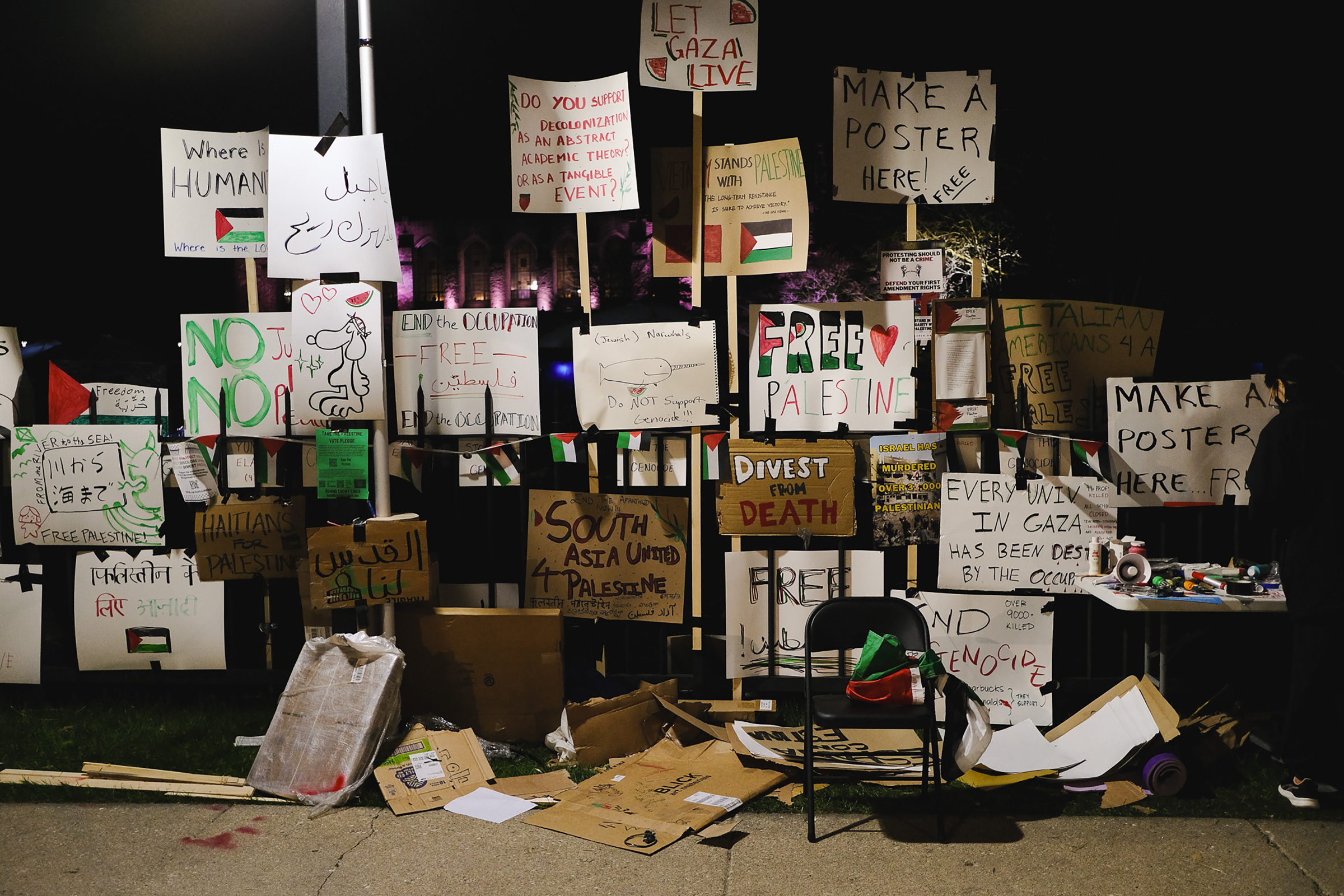
UNIVERSITY OF TEXAS AT AUSTIN
From the journalists of the Daily Texan


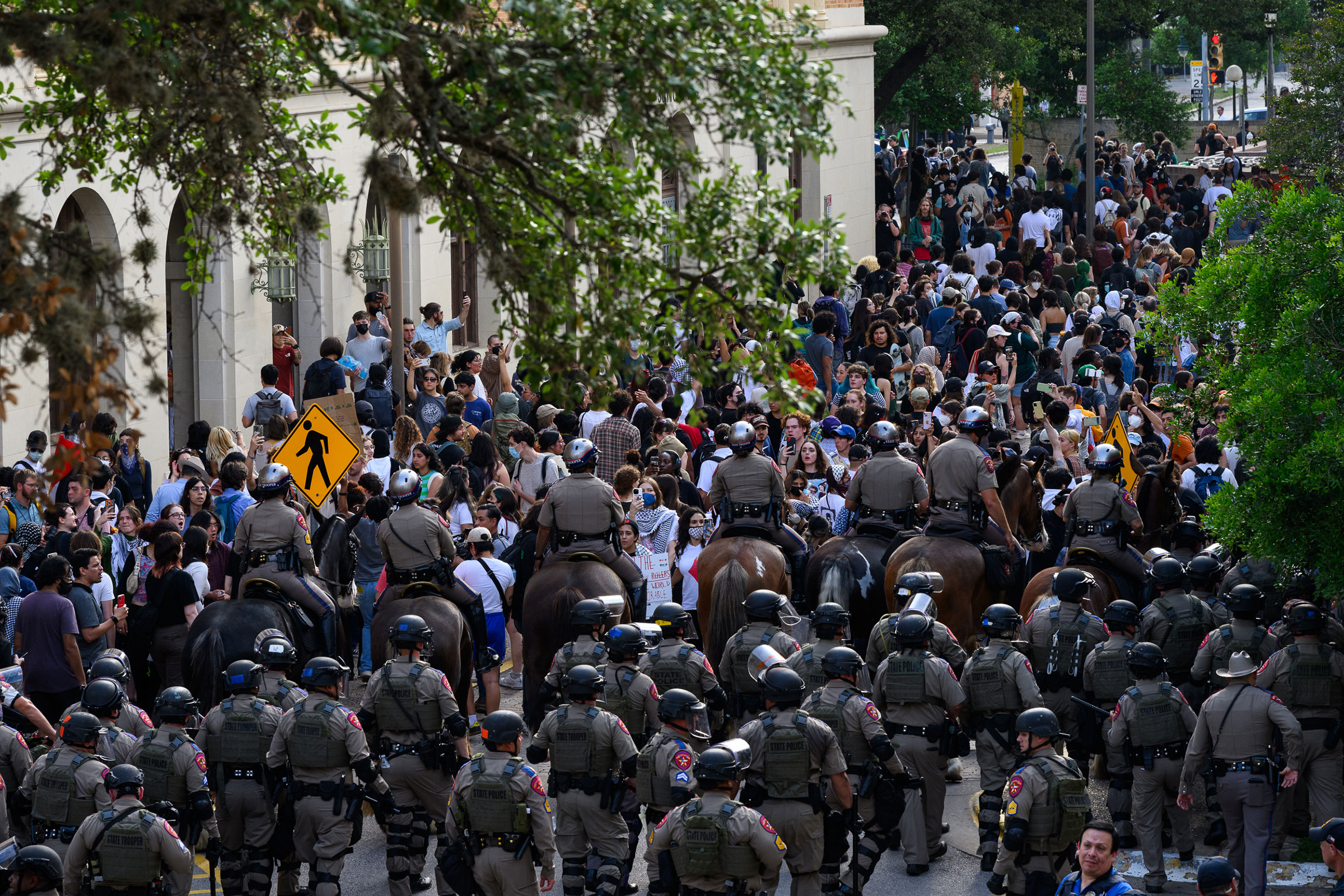
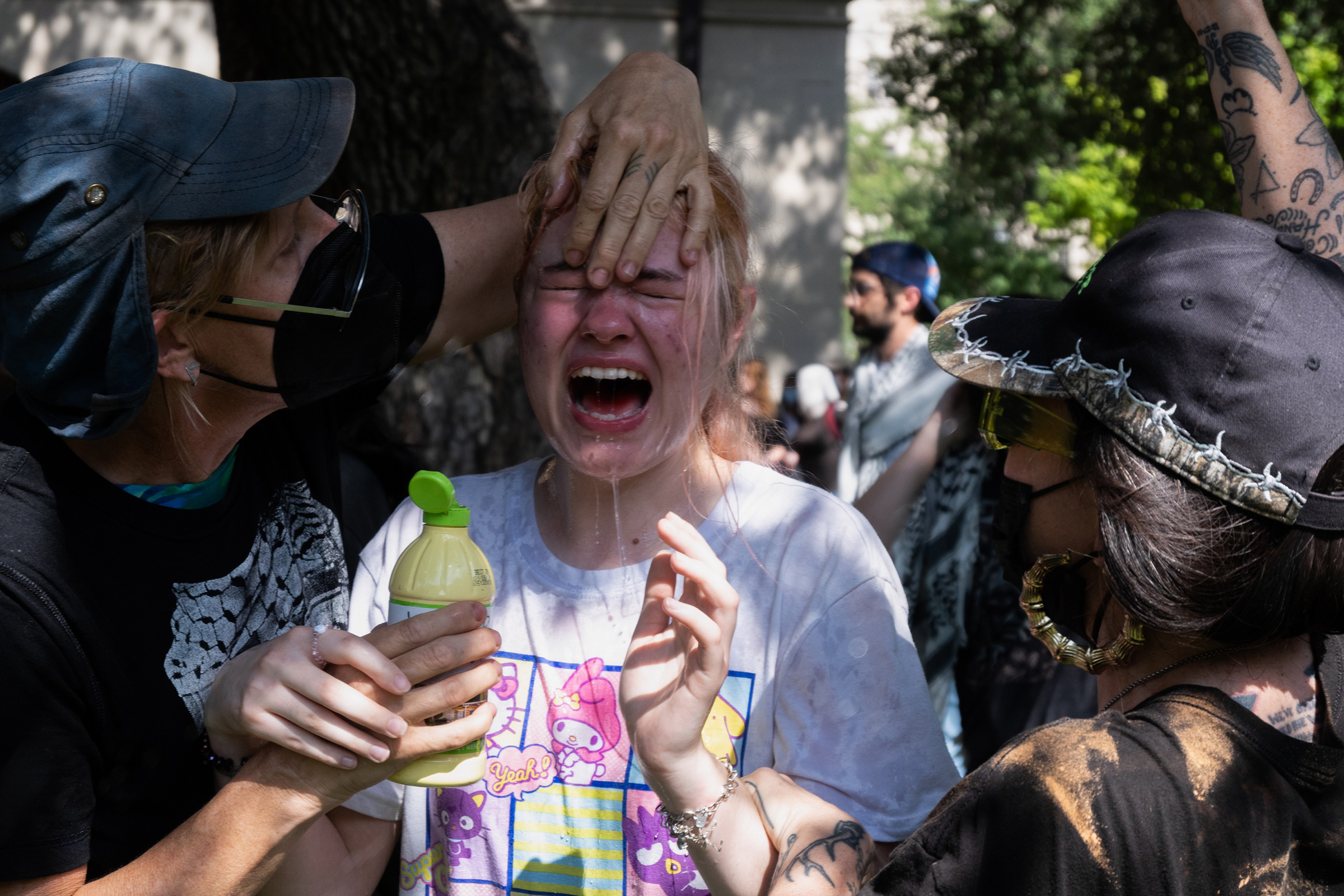
When pro-Palestinian protesters formed an encampment on the South Mall of the University of Texas at Austin on April 29, law enforcement ordered them to leave. When they refused, police encircled the space and protesters locked arms. After clearing the encampment, officers used stun grenades and pepper spray as they tried to get protesters to disperse. More than 70 protesters were arrested that day.
Students were panicking, says photojournalist Charlotte Keene, 19, who was covering the protests for the Daily Texan. “Adrenaline is really high. We were in fight-or-flight mode basically,” she says, describing police as acting in an “overly aggressive” manner.
Keene was particularly disturbed upon seeing a video and a photograph from her peers of state police grabbing a protester’s neck with one hand. “It's shocking because who would have prepared for that?” she says. The Texas Department of Public Safety did not respond to a request for comment about the image and allegations of excessive force.
Read more: Protesters Are Calling on Universities to Divest from Israel. Here’s What That Means
It was hard, Keene says, watching her peers scream as law enforcement pepper-sprayed them, and she worried about exploiting someone’s pain by photographing them in a vulnerable situation. But she knew it was her responsibility to document the way the protesters were treated – not only by the police but also by their peers, those who rushed to help with liquid to soothe the burning. “People set aside their own fear to take care of people who had been pepper-sprayed,” she says.
While Keene notes how scary the experience was for her and other journalists, she points out that those in the encampment faced an even higher risk. “I know that student journalists have been targeted, but I do feel like it’s safer for us to be there than the protesters,” she says.
UNIVERSITY OF CALIFORNIA, LOS ANGELES
From the journalists of the Daily Bruin
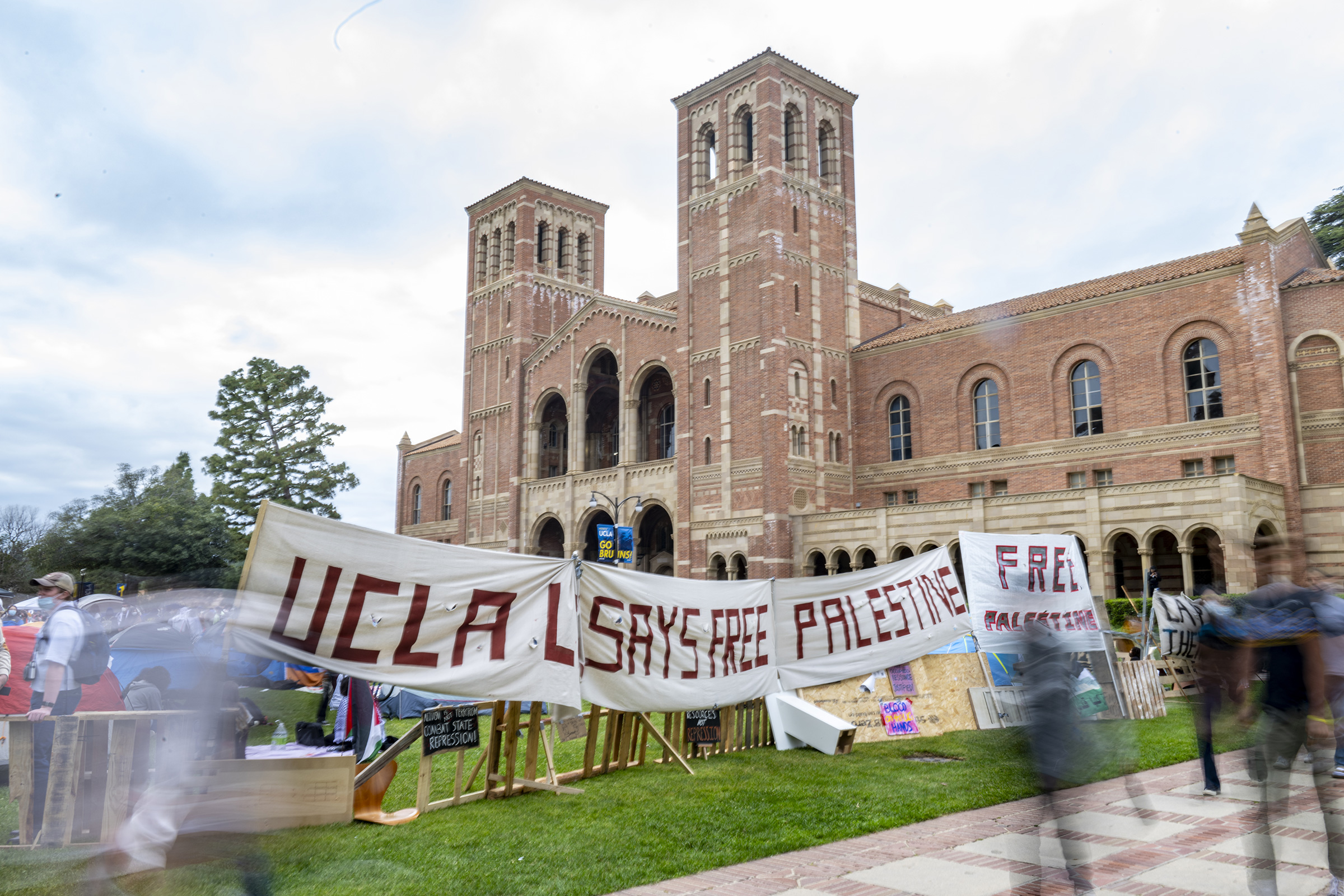
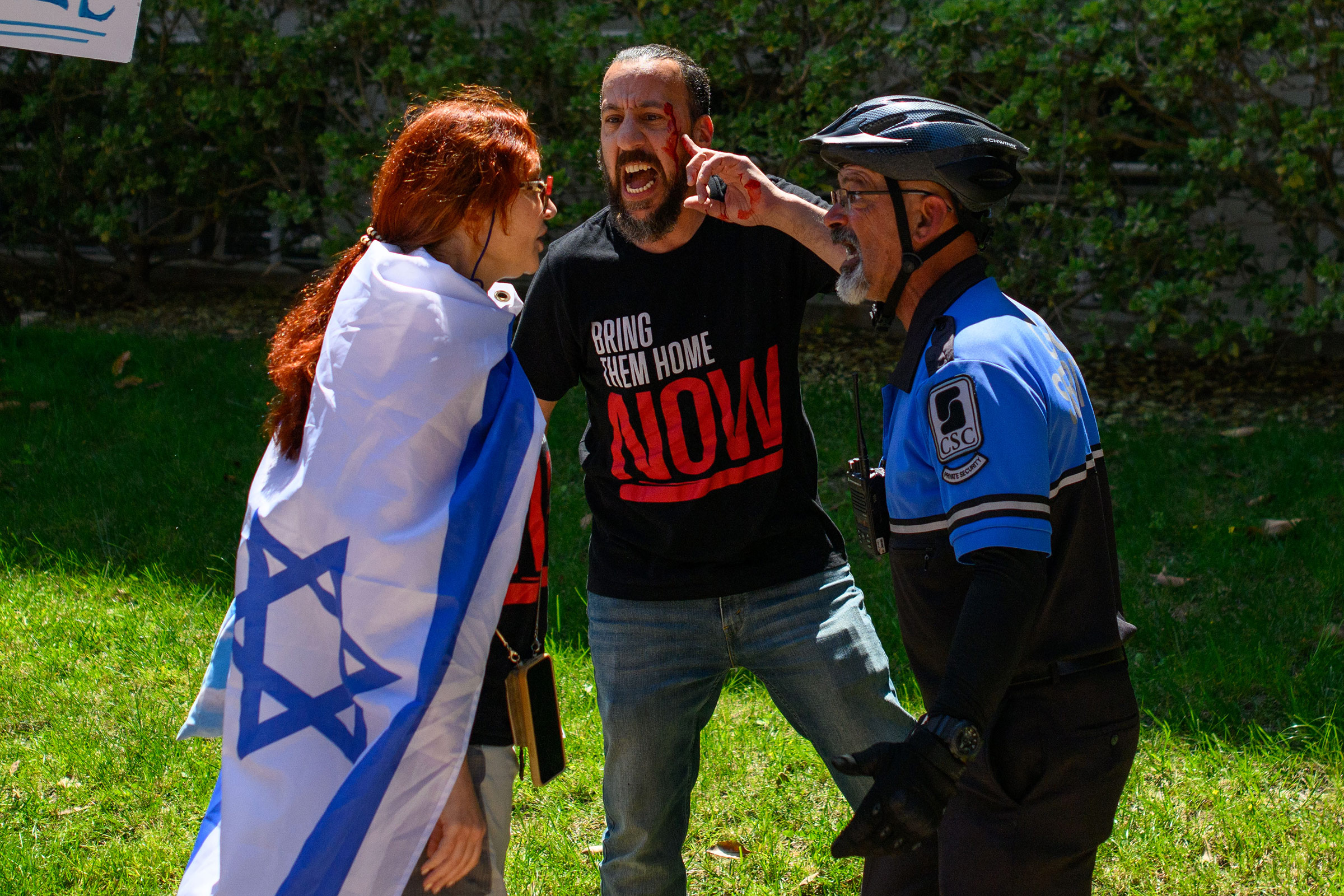

On April 25 pro-Palestinian protesters at UCLA set up an encampment. Late on April 30 and into the early morning hours of May 1, it became the site of violence after pro-Israeli counterprotesters tried to tear down the barricades and flung fireworks into the space. Four UCLA student reporters were attacked by counterprotesters, and several student protesters in the encampment were left bleeding. Police did not act for hours, sparking criticism from Governor Gavin Newsom, whose spokesperson said the response was “unacceptable” as well as “limited and delayed.”
Zoraiz Irshad, a 21-year-old senior and journalist for the Daily Bruin, was on the scene when a counterprotester and protester faced off. “The danger of what could potentially happen is what sticks out most to me in this picture,” she says, describing the atmosphere that night as “extremely chaotic and very dangerous.”
“Members of the Gaza Solidarity Encampment were trying to protect their encampment and the barricade while counterprotesters were trying to rip away the wood boards and the metal barricade,” she says.
Los Angeles Mayor Karen Bass has said that those “involved in launching fireworks at other people, spraying chemicals and physically assaulting others will be found, arrested, and prosecuted, as well as anyone involved in any form of violence or lawlessness.”
UCLA Hillel also condemned the counterprotesters’ actions, saying it did not represent the Jewish students on campus, and asked the off-campus Jewish community not to fund any actions on campus or protest there. “Your actions are harming Jewish students…The truth is that a largely peaceful, pro-Palestinian encampment was attacked by an angry, violent mob comprised of fringe members of the off-campus Jewish community last night,” they said in a statement.
Irshad watched as some of her peers were hit with wooden boards and sprayed with irritants. “As a journalist, we have to remain neutral. We want to share the facts,” she says. “But then as a student, this is something that's deeply hurting our community, so it's sometimes hard to maintain that line, but we're trying.”
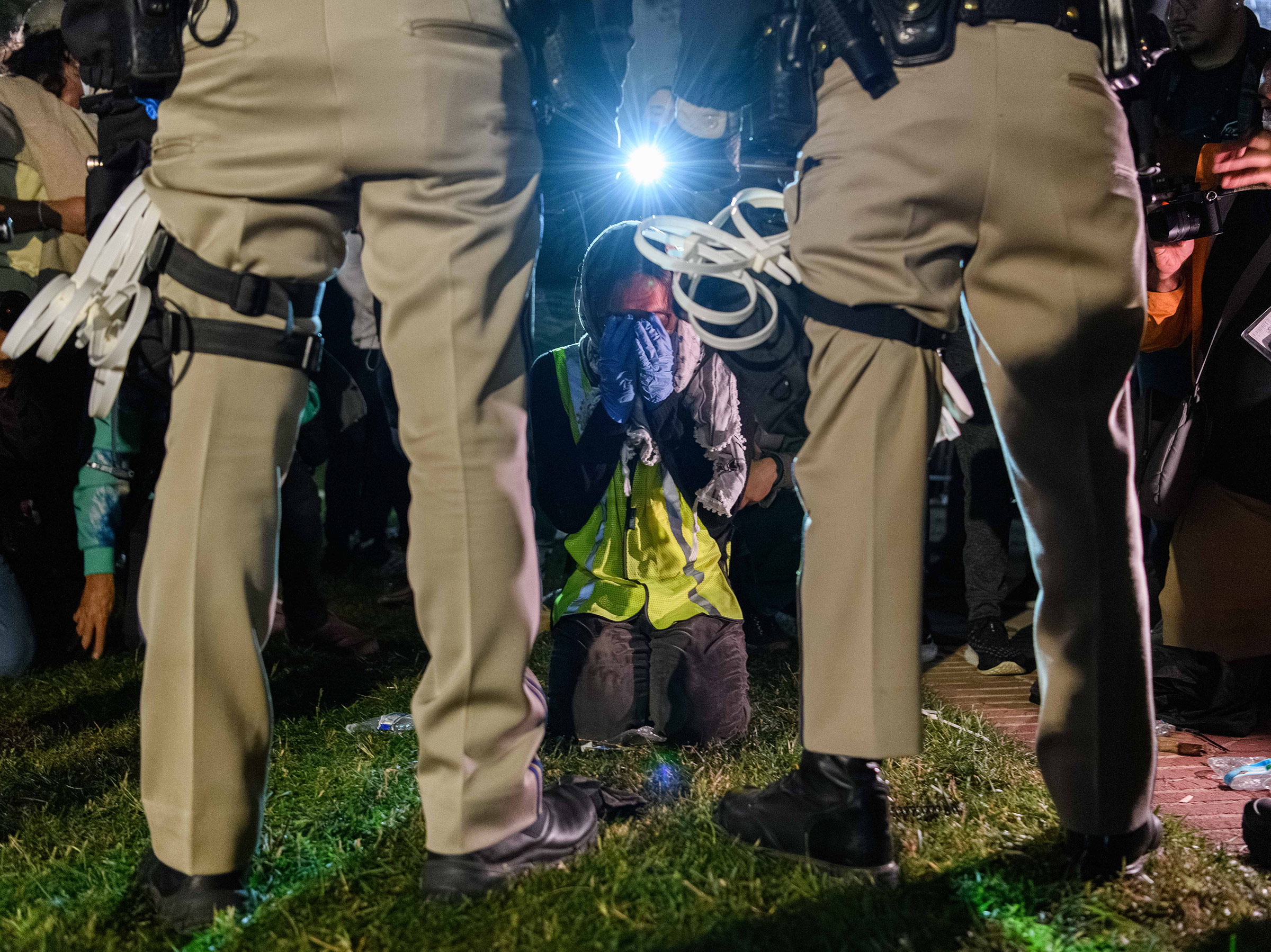
UNIVERSITY OF MICHIGAN
From the journalists of the Michigan Daily
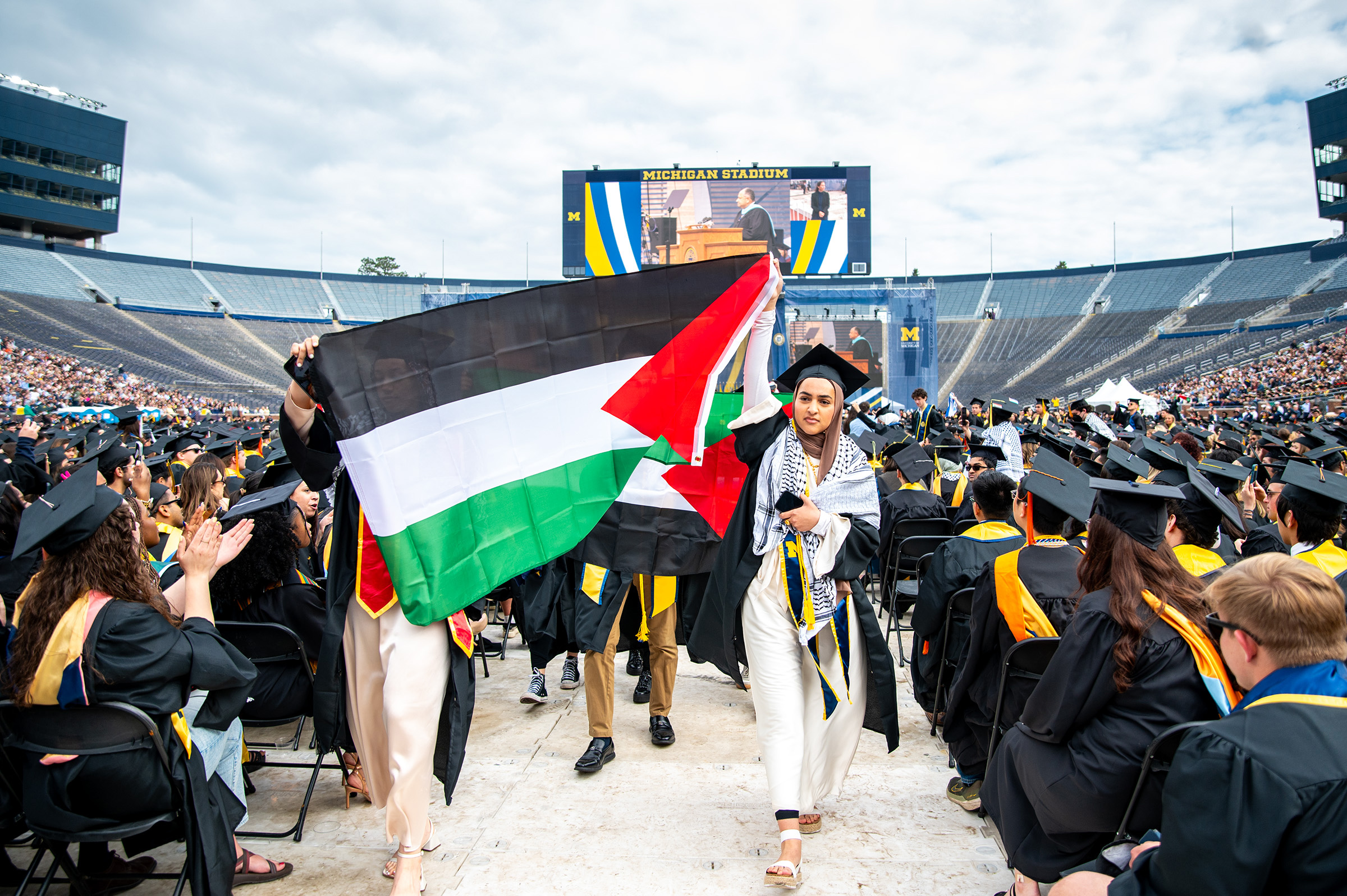
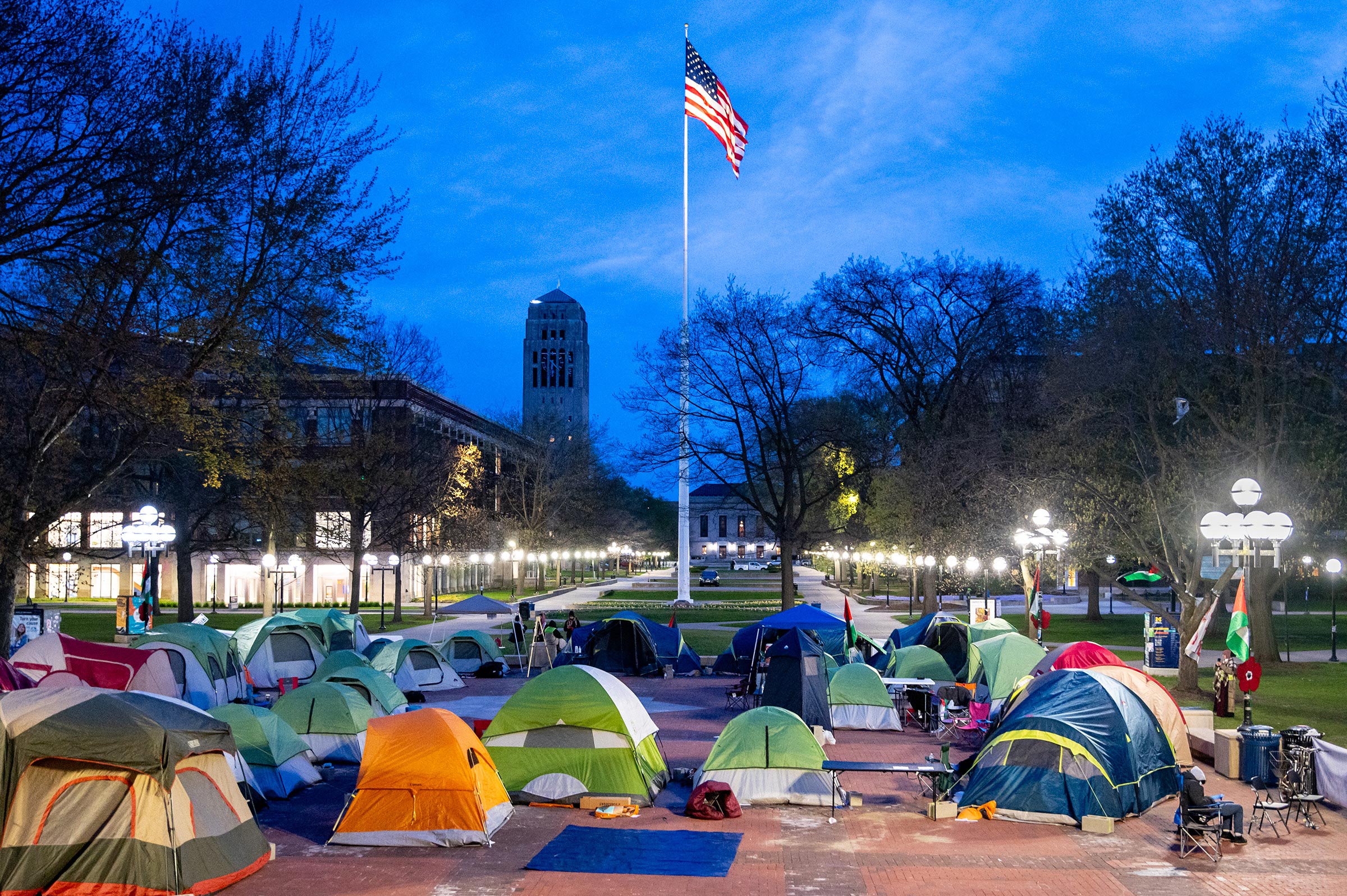
Correction, May 9: The original version of this story misstated the date Indiana professor Barbara Dennis was arrested. It was April 25, not 30. It also misstated the organization to which a CSC officer at UCLA would belong. It is Contemporary Services Corporation, not the Community Service Commission.
Correction, May 10: The original version of this story misstated the date of an altercation at UCLA. It was April 28, not 23.
Correction, May 14: The original version of this story misstated how many people were arrested at Indiana on April 25. It was 34, not 33.
More Must-Reads from TIME
- Donald Trump Is TIME's 2024 Person of the Year
- Why We Chose Trump as Person of the Year
- Is Intermittent Fasting Good or Bad for You?
- The 100 Must-Read Books of 2024
- The 20 Best Christmas TV Episodes
- Column: If Optimism Feels Ridiculous Now, Try Hope
- The Future of Climate Action Is Trade Policy
- Merle Bombardieri Is Helping People Make the Baby Decision
Write to Sanya Mansoor at sanya.mansoor@time.com
